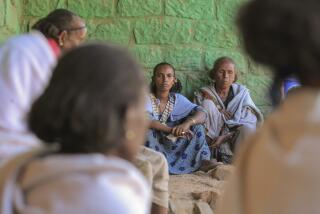‘Secret’ War in Ethiopia Targets Locusts
- Share via
MAKALE, Ethiopia — Two Englishmen were seated at a table on the hotel patio, drinking gin. Electricity had been out for hours, and it was too dark to make out their faces. They were vague about their names but, lubricated with drink, they wanted to talk.
They had an airplane, they said. They were waging a secret war, flying daily behind rebel lines. They killed every day. They used phosphate-based chemicals. Their victims--desert locusts.
“There is nothing that a locust likes to eat more than another locust,” the pilot said.
From a single-engine aircraft, the pilot rains insecticide down on swarms of locusts, killing the high-flyers first. As they fall, their cannibalistic kin eat them and are poisoned.
In seven weeks the Englishmen had “knocked down” 10 swarms. The buzzing brown clouds were, they said, three miles long, two miles wide and 600 feet high. Flying through the bug storms chokes the plane’s engine and coats its wings with a sticky brown goo. “It’s a mess,” said the pilot’s partner, a mechanic.
They were delighted with their kill ratio: millions of dead bugs to two live Englishmen. Yet they didn’t want to say too much. It was, after all, a secret war.
Rebel Territory
The Ethiopian government in Addis Ababa does not acknowledge that rebels exist in Tigray or that they control much of the region outside major towns. Accordingly, a campaign against locusts that crosses back and forth between government- and rebel-held territory is a campaign that does not exist. Thus was born the secrecy about the bombing of the locusts.
Desert locusts can eat their own weight every day. That’s only about two grams. But swarms in East Africa can get big. In 1958, aircraft in Somalia measured one swarm at 400 miles square. It contained an estimated 40 billion insects capable of eating 80,000 tons of food a day--enough to feed 400,000 people for a year.
Locusts, which travel on the wind at about 6 m.p.h., are just as happy to eat government as rebel grain.
Red Cross Backing
“What you can say is that we are allowed to fly wherever we need to go,” said Jean-Jacques Fresard, head delegate in Ethiopia for the International Committee of the Red Cross.
The Geneva-based Red Cross is not normally in the business of killing insects. Its work is aiding civilian victims of war. Normally, the Desert Locust Control Organization is responsible for combating East Africa’s periodic blooms of locusts. That agency, however, is reluctant to venture into rebel-held Tigray. So the Red Cross hired the Englishmen on the patio. The plane they fly has Red Cross markings.
Tigray is mountainous and largely roadless. Soviet-made helicopter gunships fly off almost daily from Makale airport to strike rebel positions. Government convoys are sometimes attacked by rebels within 10 miles of this regional capital.
It is not an easy place to coordinate a cross-border war on insects. Before this year, the effort had never worked. But now there are pressing reasons to make sure it does. Tigray’s 2.5 million people have been hit this year by severe drought. Next year they face famine.
The last thing that the region needs are wind-borne clouds of bugs that take food away from people.
Drawing on rebel contacts that it made in famine relief work in 1984-85, the Red Cross in recent months has developed a long-distance, three-nation, two-continent system for tracking locusts.
The locations of the insects are gathered from peasants by rebels of the Tigray People’s Liberation Front. The rebels transmit the information by radio to an office of the front in Khartoum, capital of bordering Sudan. From Khartoum, the Red Cross relays target coordinates to Geneva, which passes them on to Addis Ababa, which gives them to the Englishmen here.
More to Read
Sign up for Essential California
The most important California stories and recommendations in your inbox every morning.
You may occasionally receive promotional content from the Los Angeles Times.










